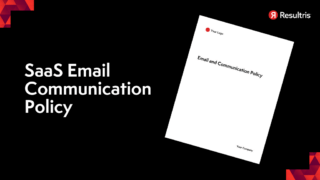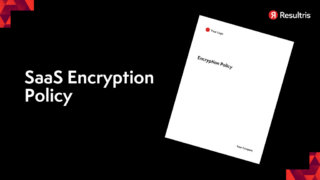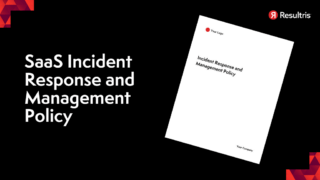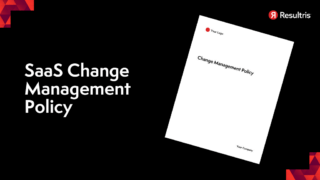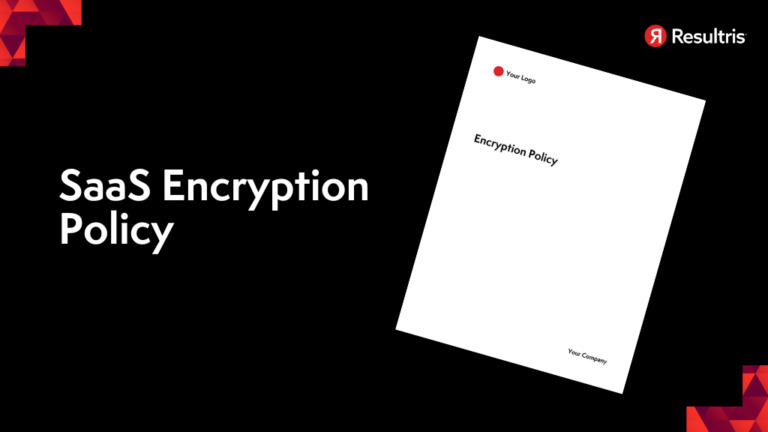
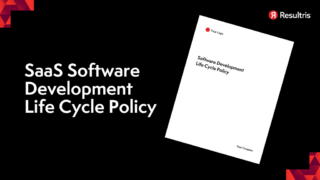
Written by: Tim Eisenhauer
Last updated:

In the digital age, nothing’s more critical than safeguarding your data. As you navigate the world of Software as a Service (SaaS), understanding the ins and outs of a SaaS encryption policy becomes crucial. It’s not just about protection—it’s about compliance, too.
Dive into the complex landscape of SaaS Compliance and Security Best Practices and learn how to ensure your data’s safety. Get a handle on the key elements of a robust encryption policy and discover how it can fortify your SaaS security strategy.
Ready to demystify the world of SaaS encryption? Let’s delve into the essentials of creating a policy that not only safeguards your data but also keeps you in line with compliance standards.
Delving into SaaS encryption policies, it’s paramount to get to the heart of their definition and purpose. Beyond that, we delve into their significance in SaaS environments.
A SaaS encryption policy outlines how Software as a Service providers encode data to prevent unauthorized access. In essence, it’s a set of guidelines that determine how information gets transformed into an unreadable format, only becoming usable again with the correct decryption key. The purpose? To ensure the highest level of data security.
In SaaS environments, an encryption policy is not just a suggestion—it’s critical. Remember, SaaS platforms store copious amounts of sensitive client data. If this data is compromised, it could lead to devastating effects including financial loss, damaged reputation, and legal penalties. An effective encryption policy mitigates these risks, providing a strong layer of defense.
In an age where data breaches are all too common, any SaaS provider worth their salt has an encryption policy in place. It’s their lifeline to secure sensitive data, from personal client information to proprietary business intelligence. Think about it, without proper encryption, sensitive data is akin to a sitting duck, ripe for compromise.
Compliance isn’t open to negotiation. Laws and regulations like GDPR and HIPAA mandate that companies secure client data. What’s more, they specify that you must have an encryption policy in place. Therefore, a SaaS company powerless before these rules—you need an encryption policy to maintain regulatory compliance.
Trust matters a lot, more so in the digital world. Clients commit their data to SaaS companies with the expectation of security. They trust these companies to treat their information with the utmost respect and protection. An encryption policy is not only a show of competence—it’s a demonstration of commitment to data security, thereby boosting customer confidence.
Crafting an effective SaaS encryption policy involves a thorough understanding of multiple components. These aspects provide the foundation for a secure and reliable policy that safeguards your valuable data and maintains regulatory compliance.
Data at rest refers to data that’s not actively moving through networks. Encrypting data at rest adds a layer of protection, making it more challenging for unauthorized individuals to access sensitive information even in the event of a physical or digital security breach.
For data in transit, that is, data being transferred over networks, encryption is equally vital. Data in transit encryption ensures that even if data interception occurs during transit, the information remains inaccessible and unreadable to the intruder.
End-to-End Encryption (E2EE) is another essential type of encryption. This method ensures that only the sender and the intended recipient can decrypt and access the information. Even if a breach occurs at intermediary stages, the data remains secure.
Encryption standards and algorithms play a crucial role in determining the strength and effectiveness of the encryption. Some of the commonly used standards include AES (Advanced Encryption Standard), RSA (Rivest-Shamir-Adleman), and ECC (Elliptic Curve Cryptography). Stronger algorithms provide better encryption, but they can also require more computational resources.
Key management includes all aspects of handling cryptographic keys—creation, distribution, storage, rotation, and deletion. Proper key management practices are vital as they ensure that encryption keys (which decrypt your encrypted data) are kept secure. Improperly managed keys can lead to unauthorized access and potential data breaches.
Access control refers to the process of determining who can access the encrypted data. It’s crucial to have measures in place to authenticate users before allowing data access. This could involve using passwords, biometric authentication, or two-factor authentication. Access control systems help prevent unauthorized access, ensuring that only approved users can manipulate the encrypted data.
Using these components as a foundation, you can develop a robust, effective SaaS encryption policy that not only enhances your data protection protocols but also helps you meet compliance regulations and build trust with your customers.
In the enactment of a powerful SaaS encryption policy, several stakeholders play unique, indispensable roles. This section unearths their specific responsibilities.
Leadership steers the ship when it comes to encryption strategy. They provide vision, direction, set policy objectives, and mobilize resources. It’s essential for these key figures to understand the technology and legislation surrounding SaaS encryption.
Often, leadership boils down to two key roles: executives and board members. Executives, for instance, CEOs or CTOs, ensure the alignment of the encryption strategy with overall business goals. Board members, on the other hand, provide oversight, evaluate performance, and mitigate risks associated with SaaS encryption practices.
IT and Security teams turn the encryption strategy vision into reality. Armed with technical expertise, they oversee the selection and implementation of encryption standards and algorithms. They also handle encryption key management. Not only do they ensure secure key creation, storage, and renewal, but also the secure decommissioning of outdated keys.
An equally pivotal part of their job includes safeguarding data not only in transit but also at rest. For this, the teams implement robust access controls, perform regular audits, and uphold data integrity even in the face of threats like data leaks or breaches.
Developers sit in the driver’s seat of actual encryption implementation. They integrate encryption libraries within the software, ensuring secure handling of data across SaaS applications. It hinges on their diligence that end-to-end encryption becomes a reality, protecting data from unauthorized access or tampering.
When it comes to development work, adopting standardized code libraries is key. These offer pre-written encryption algorithms, saving time, and reducing errors. Developers should also apply secure coding practices, minimizing vulnerabilities in the software that could be exploited.
Employees form the front line in the practice of an organization’s SaaS encryption policy. Although they might not handle the technical intricacies, understanding basic encryption principles and practices is crucial. Training programs impart knowledge on encryption key handling and the significance of secure password practices.
In essence, training focuses on promoting a culture of data security. It helps employees identify and report potential security risks, understand their role in safeguarding data, and appreciate the importance of stringent encryption standards and secure data handling procedures.
This section brings attention to the sequential process involved in crafting an effective SaaS encryption policy. The subsequent subtopics delve into assessing data sensitivity and encryption needs, setting encryption rules for diverse data types, deciding on key management protocols, and establishing a robust response system for potential encryption failures.
Start by identifying your most critical data. Classify data into categories such as Public, Internal Use, Classified and Restricted. For instance, customer information or Intellectual Property (IP) might fall into Classified or Restricted. Then, evaluate encryption needs according to sensitivity. Let’s remember that high-risk data require stronger encryption measures.
Each identified data category demands specific encryption standards. As a basic rule, Public data may require minimal encryption, while Restricted data demands advanced and complex protocols. For instance, Sensitive Personal Information (SPI) gets the latter treatment due to stringent privacy laws across various jurisdictions.
Next up, you’ll tackle key management – the linchpin of encryption. Create standardized procedures for key generation, rotation, storage, and disposal. Remember, established protocols minimise risk and enhance security. You might use a reputable Key Management Service (KMS) to streamline this process and shield keys from unauthorized access.
And lastly, an incident response plan for encryption failures becomes crucial. Quickly detecting and addressing failures reduces potential damage and downtime. Draft protocols for identification, containment, eradication, and recovery. Post-incident actions, including a detailed analysis of the event and steps taken, also form an integral part of this process. Testing the plan periodically ensures it’s effective when you need it most.
Crafting an encryption policy seems challenging, yet it’s a practical hurdle you’re set to overcome for effective SaaS security. From strategic technical implementations to employee training, the comprehensive steps ensure a highly secure environment. Let’s delve into the crucial details of policy enforcement.
Time to put the theory into practice. Technical implementing your SaaS encryption policy requires thought-out tactics. Think of strong encryption algorithms, like AES 256. Their inherent structure strengthens security, making them a go-to for many businesses. Additionally, proper deployment of a secure key management system limits potential breaches, preserving the sanctity of your data. Remember, regular system audits help gauge the effectiveness of the security measures, catching errors before they become critical threats.
Integration is no less crucial in the encryption process. Coherent workflows ensure your encryption policy doesn’t disrupt your daily operations. Consider secure APIs for seamless policy integration. The effective bridging of existing systems mitigates operational glitches, ensuring streamlined, unhindered work processes. Also, adopt a data-centric model; your encryption policies must protect data regardless of its location—which is, at any given moment, predictable. Ultimately, ensuring compatibility between systems is key in this stage.
Lastly, human resources aren’t to be ignored. The best encryption policy doesn’t help if your team isn’t versed in its intricacies. Create an engaging training plan focused on understanding and implementing the policy rules. Regular refresher courses and awareness programs about latest threats and countermeasures ensure your employees stay alert, bolstering your overall SaaS security. Remember, security is a team effort, and each team member’s competence is vital. So, don’t hesitate in investing in quality training and development programs. Now, with this understanding, you’re well-equipped to take on the challenges of implementing your SaaS encryption policy.
After understanding the gravity of SaaS encryption policies and the essential steps involved in forming one, maximizing their applicability is the next big step. Key areas that demand focus while implementing an encryption strategy include regular key rotation and management, encryption performance optimization, and effective techniques for monitoring and auditing encryption processes.
Robust key rotation is pivotal for maintaining the integrity of your encryption strategy. Key rotation involves replacing existing cryptographic keys with new ones at regular intervals, thereby reducing the risk of unauthorized access.
Here are some pointers:
Encryption, though important, can impact the system’s performance. It’s crucial to find the right balance between data security and optimal performance.
Follow these practices:
To ensure the successful execution of encryption policies, consistent monitoring and auditing is crucial. It helps keep track of any anomalies or vulnerabilities that can compromise data security.
Here are some best practices:
Incorporating these best practices into your SaaS encryption policy enhances data security, improves encryption performance, and streamlines monitoring and auditing of encryption processes. This not only propels your brand’s credibility but also ensures a robust defense against potential cyber threats.
In the current landscape of SaaS encryption, several hurdles can complicate data protection efforts. Knowing these potential pitfalls can aid in navigating the encryption maze with finesse.
One significant challenge is balancing security through encryption with system performance. Encrypting data, especially large data sets, can introduce inevitable latency. Your system executors must constantly perform encoding and decoding operations, causing a potential performance hit. For instance, demanding encryption requirements for a cloud-based customer relationship management (CRM) system may affect data retrieval and report generation speed. Remember that, while security is vital, so is your operational efficiency and end-user satisfaction. Striking a balance is crucial.
Handling encryption in a multi-tenant SaaS environment is a complex act. The necessity to isolate each tenant’s data conveys specific encryption strategies. Each tenant’s data and keys must be completely secured, even from other tenants on the same platform. In a report from Gartner, 66% of organizations expressed concern over multi-tenant data breaches. Therefore, strategies like segregating tenant data using unique encryption keys or enforcing strict access policies are essential to mitigate those risks.
Lastly, dealing with legacy systems and data migration presents unique challenges. Legacy systems may not be designed for modern encryption algorithms, leading to potential compatibility issues. Similarly, data migration to a SaaS platform may involve significant encryption undertakings. Unencrypted data must be encrypted before moving it to the cloud. Moreover, a study by the SANS Institute revealed that 48% of organizations had concerns over data exposure during transit. Hence, a sound strategy that incorporates data scrambling, encryption, and secure transfer methods is essential during this phase.
Indeed, these challenges are worth acknowledging for any organization concerned with maintaining a stalwart encryption policy. Overcoming these difficulties confirms your commitment to data security, resulting in improved business credibility and trustworthiness.
After meticulous crafting of your SaaS encryption policy and extensively dealing with challenges, gauging the effectiveness of your encryption efforts takes precedence. This segment provides insights into key measures likes KPIs, security incident metrics, and adherence to compliance audits.
Identify quantifiable measures as Key Performance Indicators — the guardians of your encryption strategy. They report on the effectiveness and adherence to policy protocols.
Tracking security incident metrics related to encryption is vital. You can classify them into:
Adherence to regulatory norms reflected through compliance audit success rates is another pivotal measure. After all, higher success rates re-emphasize conformity to encryption policy and regulatory guidelines.
Moreover, audit trails highlight areas of non-compliance, providing a roadmap for remedial actions. Therefore, aim to achieve successful audit results, as it amplifies stakeholders’ trust and fortifies your organization’s reliability.
Continuing the journey of SaaS encryption policy, we now dig into legal and regulatory factors, these can’t be overlooked. It’s an environment of constant adjustments as global and sector-specific rules evolve.
Move into European sphere, you’ll find the General Data Protection Regulation (GDPR). Enforced as of May 25, 2018, GDPR has reshaped the way organizations approach data privacy. It mandates encryption for a personal data category, stressing the importance of having a competent SaaS encryption policy. GDPR non-compliance can attract fines to the tune of 20 million Euros or 4% of your global turnover, whichever is greater. No small change, right?
Prioritize transparency in data processing under GDPR. Display how you handle an individual’s data – from collection to processing to storage. Implement a robust encryption policy and risk management system, this ensures your SaaS platform adheres to these necessary regulations.
Let’s narrow down to industry-specific compliance. In the healthcare sector, for instance, there’s the Health Insurance Portability and Accountability Act (HIPAA). Firms handling patient data must employ encryption mechanisms as per HIPAA Security Rule. HIPAA breaches can lead to fines up to $1.5 million annually. This places emphasis on HIPAA-compliant SaaS encryption policies, doesn’t it?
Also, in the scope of credit card transaction security, Payment Card Industry Data Security Standard (PCI DSS) comes forth. It abides businesses accepting card payments to secure environment and encrypt transmission of cardholder data across open, public networks. Hence, your SaaS encryption policy plays a vital role in achieving PCI DSS compliance.
The realm of SaaS encryption is not just bound to industry-specific or data protection regulations. Various governments worldwide have their rules governing the use of encryption technologies. For instance, in the USA, encryption tools are contended with Export Administration Regulations (EAR).
Now the pivotal question – Does your SaaS encryption policy meet these diverse regulatory mandates? Do you actively respond to the ever-shifting legalities and stay compliance-ready? The answers lie in understanding your industry’s compliance landscape, gauging your data handling practices, and maintaining robust, flexible encryption policies. Your encryption policy isn’t just a technical necessity. It’s a legal prerequisite too. Keep this in mind as the foundation of your secure, law-abiding SaaS platform.
Following our discussion on encryption standards, key management practices, regulatory considerations, and the broader context of SaaS encryption policies, let’s delve into the specific strategies within varying deployment models.
In public cloud environments, encryption is vital for protecting your data. Cloud service providers typically offer built-in encryption features. However, it is crucial to understand your particular requirements and ensure they align with the provider’s capabilities. Remember, the degree of control over encryption methods and key management varies among providers.
For example, AWS offers services like AWS Key Management Service (KMS) and AWS CloudHSM, allowing customers to manage and control their encryption keys. Google Cloud provides similar services via Google Cloud KMS and Google Cloud HSM.
However, while relying on the provider’s infrastructure for cybersecurity may seem convenient, implementing additional encryption mechanisms is wise.
Such actions can include deploying third-party security solutions, encrypting data before it is moved into the cloud, or using split-key encryption where different parts of the decryption key are stored separately.
With private cloud and on-premises models, taking active responsibility for encryption and key management can be more straightforward. Unlike public clouds, you maintain total control over the infrastructure and have access to all of its security controls.
For instance, you can implement robust data encryption algorithms, such as AES 256-bit encryption. You also retain full control over your encryption keys and how they’re stored, allowing for more flexible key management practices such as rotating and revoking keys or leveraging Hardware Security Modules (HSMs).
However, the risk here is becoming complacent. Overseeing encryption internally means that your organization needs to maintain security vigilance, stay updated with best practices, and continually evaluate your encryption approaches.
A hybrid cloud approach, combining elements of public and private clouds, represents a different set of encryption challenges. Implementing consistent encryption standards and key management practices across both environments can be difficult, primarily due to the varying control levels over the infrastructure.
Ensure that encryption measures are synchronized across different platforms, and interoperability is maintained. An integrated key management system, bridging public-cloud provider tools and your own, can be ideal for a hybrid environment.
While managing data in transit and at rest, using the same encryption approach on both public and private segments of the hybrid cloud brings a harmonious security protocol. It’s not without its challenges, but achieving this balance could be a significant step towards effective and compliant SaaS encryption.
Progressive advances in technology and ever-evolving cybersecurity threats breed dynamic trends in SaaS encryption. You’ll find distinct trends dominating the encryption landscape–Quantum-resistant encryption, Homomorphic encryption for data processing, and employing Blockchain in encryption key management. Let’s delve into each.
Chaotic as it sounds, there’s growing concern that quantum computers could crack standard encryption algorithms existing currently. It’s in this backdrop that Quantum-resistant encryption emerges as the vanguard protecting against potential quantum computer attacks. This novel encryption technology uses algorithms thought to be resistant to quantum computing attacks. Quantum-resistant encryption deploys a range of methods such as lattice-based cryptography, hash-based cryptography, and code-based cryptography, offering an added layer of security.
In 2019, the National Institute of Standards and Technology (NIST) launched a project to standardize quantum-resistant algorithms. By 2023, they aim to introduce draft standards, potentially taking us a leap closer in countering quantum threats.
Confused about processing encrypted data without ever decrypting it? Homomorphic encryption makes it a reality. A revolutionary privacy-preserving computation method, it allows direct computations on encrypted data, producing an encrypted result which, when decrypted, matches the result of operations performed on the plaintext.
For instance, consider this Azure cloud scenario. Microsoft Azure confidential computing uses homomorphic encryption, ensuring encrypted data remains confidential even while it’s being processed.
Imagine streamlining key management with complete transparency and a tamper-evident record. That’s what adding Blockchain to the mix accomplishes. Blockchain presents a decentralized way of managing and distributing encryption keys, reducing the possibility of single points of failure and offering enhanced security against tampering.
As an example, Guardtime utilizes a blockchain-based Keyless Signature Infrastructure for large-scale data integrity assurance. This scalable system updates, distributes, and verifies the integrity of encryption keys, providing a solid testament to blockchain’s potential in encryption key management. Irrespective of the changing times and trends, an effective SaaS encryption policy stays paramount in maintaining impeccable data security.
In the arena of SaaS, encryption isn’t just an optional, add-on feature: it’s a must-have. Let’s venture into how you manage your customers’ data and the importance of transparent communication, customer control over encryption keys, and considerations in data residency and encryption.
Transparency reigns supreme in managing customer data. It’s not enough for you to implement robust encryption practices; you’ve got to communicate these to your clients confidently and clearly. For instance, details about the method of encryption—128-bit or 256-bit AES encryption, for example—should be openly shared. Similarly, you should explain the lifecycle of encrypted data, from the moment it enters the system to the points of storage and retrieval. It’s essential to demystify encryption for customers, robbing it of its perceived complexity. An educated customer appreciates the steps you’ve taken to ensure their data remains secure.
In managing customer data, allowing the customer control over encryption keys introduces an added layer of safety. If you’ve gone through the process, you know the drill! Customers with access to their encryption keys wield control over who views their information. For illustration, consider a SaaS company that offers customers private, exclusive encryption keys. The customers hold the digital keys to their kingdom, regulating who enters and who doesn’t. This results in increased trust and, importantly, customer satisfaction.
As you delve into customers’ data management, considerations around data residency arise. It’s not just about where customers’ data sits; it’s about how encrypted it is. For instance, if you are a SaaS provider with servers in the European Union, you must adhere to the General Data Protection Regulation (GDPR). The GDPR has strict guidelines for encryption, and non-compliance incurs hefty fines. Similarly, data hosted in the United States is subject to specific regulatory standards. Understanding global guidelines for data residency and encryption both protects your customers and fortifies your reputation as a secure, reliable SaaS provider.
In managing customer data, remember that encryption isn’t just a term; it’s crucial for the survival and growth of your SaaS platform. Be transparent with customers about your encryption practices, allow them control over their encryption keys, and be vigilant about data residency and encryption guidelines.
Transitioning encryption strategies into the realm of software development necessitates meticulous planning. Injecting security into every phase of the development process isn’t just advised, it’s crucial.
Secure coding takes center stage when embedding encryption in software development. This practice starts with employing encryption algorithms, like RSA or AES, at the coding phase. But remember, choosing these algorithms isn’t a one-and-done deal. Revisit them periodically as updates or advancements occur in encryption standards. For example, deprecating older algorithms such as DES or Skipjack helps stay current. Essential too is avoiding hard-coded cryptographic keys in your software’s source code. They’re a veritable honey pot for attackers seeking to undermine your security measures. Always keep these keys apart, ideally inside a key vault or a similar secure storage facility.
After introducing encryption in development, it’s time to validate these measures. This process involves rigorous testing to affirm the resistance of your encryption schemes to potential threats. Peer code reviews, an effective validation technique, provides a form of double-checking. Here, experienced developers examine the encryption application for any potential oversights or vulnerabilities. Employing third-party penetration testing doesn’t hurt either. This external check, often through simulated cyber attacks, helps uncover any latent weaknesses that could compromise the security of your system.
Encryption isn’t a security panacea; you must continuously verify these measures to ensure their continued efficacy. Routine audits of your encrypted systems form one aspect of this ongoing assessment. For instance, checking on encryption keys’ rotation policies or exploring how data is secured while in transit both contribute to maintaining secure operations. Additionally, investing in threat intelligence platforms could alert you to potential security threats before they impact your encrypted systems. Consider this proactivity in security management a small price to pay for the invaluable asset of maintaining trust with your customers, partners, and regulators.
In the software development lifecycle, encryption is a continual commitment to secure operations—not an optional extra. Your software’s constant evolution reflects that of the threat landscape. Stay ahead, continuously evaluate and adapt your encryption policies to take on whatever security challenges come your way.
Previously, we’ve delved into essentialities of SaaS encryption policies, secure coding practices, and ongoing security assessment. Now, let’s tackle what’s typically a dreaded scenario: dealing with encryption key loss or compromise. Here, we’ll elaborate on key recovery procedures, incident response, and business continuity planning.
Handling encryption key loss isn’t the end of the world. Having a robust key recovery procedure in place acts as your insurance policy. Typically, a key recovery scheme consists of securely storing backup keys, often in an encrypted format themselves, and having a strict protocol for their retrieval, thus providing you with a recovery path in the event of key loss. Of course, these procedures have to be governed by stringent access controls to prevent unauthorized use.
Dealing with key compromises requires an effective incident response plan. Such a plan incorporates immediate isolation of affected systems, swift identification of the breach extent, and containing it from becoming widespread. Invariably, a key compromise necessitates the immediate generation and propagation of a new key across your cloud infrastructure. Concurrently, it’s vital to conduct a thorough, timely post-incident analysis, diving deep into the cause and effect, so preventive measures can be put in place for the future.
Finally, preparing for encryption failures defines a resilient SaaS setup. Business continuity planning involves designing redundant systems that take over in the event of an encryption failure, minimizing the disruption to your services and data accessibility. This planning includes regular backup of your essential data and their encrypted keys, diversifying your encryption strategies, and potentially exploring Quantum-Resistant Encryption to buffer against any decryption risks. An effectively planned and tested Business Continuity Plan ensures your service availability and data security, no matter the encryption hitch you encounter.
Striking the perfect balance between airtight encryption and data usability is crucial in SaaS environments. The forthcoming sections grant insights on various aspects such as searchable encryption techniques, performance considerations, and designing user experiences with encrypted data.
Searchable encryption techniques, let’s say for instance, deterministic encryption, blind storage, or wildcard searchable encryption, are remarkable advances that ensure encrypted data remains searchable. They transform encryption from a hindrance to a functional asset. To put it simply, they allow specific queries to be performed on encrypted data, without the necessity of decryption. Casting an eye over renowned platforms, Google’s Encrypted BigQuery service offers a notable example. It provides the ability for SQL-like query on encrypted data in a cloud.
Real-time system performance is severely impacted by heavy encryption processes. Issues of latency, resources allocation, and scalability frequently crop up, impacting business functions. Illustrative examples encompass systems like CRM or ERP that require real-time data processing. In response to these challenges, newer encryption methods that lower computational overhead are coming to the fore. A viable option for real-time systems can be lightweight encryption mechanisms such as stream ciphers, again, a case in point could be the RC4 algorithm.
Grappling with the complexity of user experience design with encrypted data is no small feat. Encryption can often impede user accessibility and interface responsiveness. Browsing encrypted emails and documents can be slower and less intuitive, affecting productivity and efficiency. Cloud service providers are constantly navigating this junction of necessity and convenience. Techniques such as client-side encryption, for example, ProtonMail’s use of OpenPGP, aim to marry security with usability. Striking this balance correctly has the potential to augment your SaaS application’s adoption and enduring success.
Navigating the maze of international encryption standards can be a taxing ordeal. However, understanding these may lead to a better grasp on the intricacies of SaaS encryption policy at a global level.
Export controls on encryption technologies establish benchmarks for particular countries. Mandated by authorized entities like the U.S. Department of Commerce, these controls provide guidelines on transporting encryption mechanisms across national borders.
Think of it in these terms: Not every country allows the same level of encryption. For instance, in the U.S., encryption technologies are subject to export controls under the Export Administration Regulations (EAR), which classifies certain cryptographic software as ‘dual-use items’. The EAR restricts the export of these items except under specific license exceptions.
Cross-border data transfers play a vital role in the digital economy, especially for global organizations deploying SaaS services. For seamless operations, data often get transferred between international data centers or stored in various locations worldwide.
This raises the issue of encrypting sensitive information and complying with diverse data protection regulations. The European Union’s General Data Protection Regulation (GDPR), for example, heavily emphasizes data encryption to ensure data privacy during these transfers. Also, note Privacy Shield, which oversees data transfers between the U.S. and the European Union.
Being ahead of the curve means knowing the legal stipulations and abiding by local encryption laws where your business operates. Different countries adhere to various encryption standards and laws. Consider China, where businesses are required to submit encryption codes for Government review—in stark contrast to the EU’s GDPR.
Being aware of these differences, understanding local regulations and staying updated with changes are fundamental to maintaining smooth operations and avoiding breeches in compliance, especially when operating a SaaS business on a global scale. Remember, it’s not just about using encryption; it’s about using it legally and effectively.
You’ve journeyed through the complexities of SaaS encryption policies. You’ve seen the value of encryption methods, the challenges of managing them, and the impact of regulations like GDPR. You’ve also gained insight into the role of innovative trends like Quantum-Resistant Encryption, Homomorphic Encryption, and Blockchain in Encryption Key Management.
You’ve discovered how to navigate international standards and export controls on encryption technologies. You’ve learned about the hurdles of cross-border data transfer and the need to comply with local encryption laws.
It’s time to leverage this knowledge. It’s time to develop a comprehensive and robust encryption strategy for your SaaS business. It’s time to ensure data security and regulatory compliance on a global scale. Remember, a well-crafted encryption policy isn’t just about protecting data—it’s about building trust with your customers and growing your business.
Disclaimer
Please note that the information provided in this blog post is for informational purposes only and does not constitute legal advice. We are not lawyers, and reading this content does not create an attorney-client relationship. For legal advice specific to your situation, please consult with a qualified attorney.

